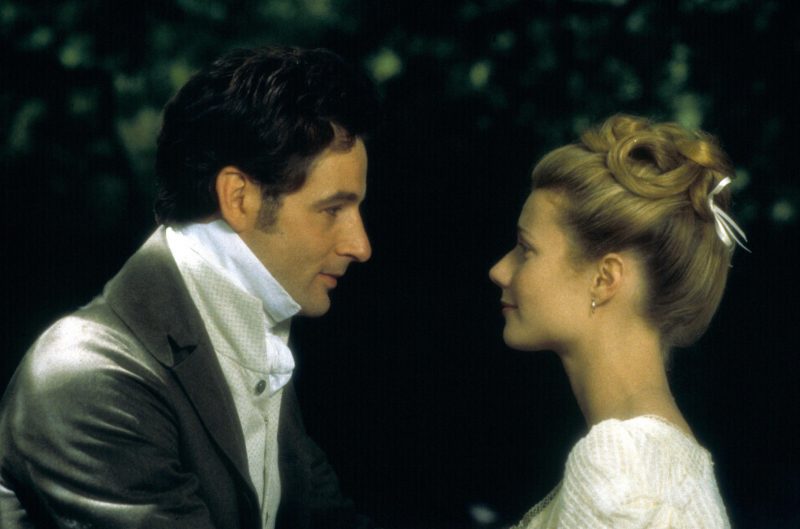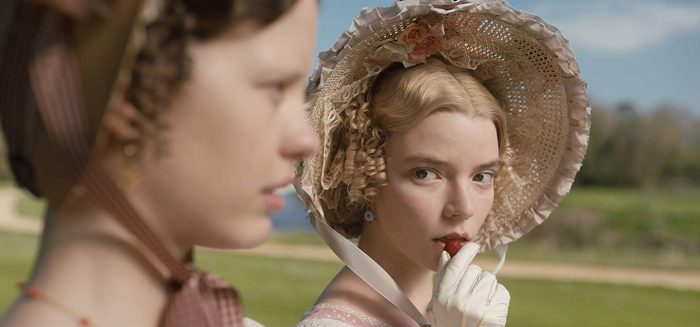By Hannah White
It often feels like today is mirroring the Austen craze of the 90s. Historical or period dramas like Bridgerton and The Great are dominating streaming services. Netflix announced that Bridgerton, the soapy, modernized drama set in Regency England, has become their biggest series ever. Another modern take on a classic 19th century book by Austen, Emma (2020), starring Anya Taylor-Joy, has been acclaimed by viewers everywhere. In anticipation of the upcoming Oscars in which Emma received multiple nominations, I rewatched this new adaptation along with the 1996 Emma starring Gwyneth Paltrow, and here are my thoughts on how they stand up to each other.
Characters
Gwyneth Paltrow’s Emma is beautiful and likeable even when she becomes blinded by her selfish conceit regarding her matchmaking abilities. This Emma comes across as a sincere yet humanly flawed person whose transgressions can easily be forgiven. She is soft, rosy cheeked, and conventionally beautiful.
But the new Emma played by the striking Anya Taylor-Joy comes across as much more brazen and self-centered, particularly at the beginning of the film. Yet this characterization pays off with a much more dramatic–and in my opinion more satisfying–character arc than in the 1996 film. Austen herself said that Emma was “a heroine whom no one but myself will much like.” The 2020 Emma is even more headstrong than Gwyneth Paltrow’s, and she is unlikeable at times (think the picnic scene where she insults poor Miss Bates), yet I think this portrayal makes her even more delightfully human and interesting.
Taylor-Joy’s Emma feels much more modernized and less stale than the portrayal from Paltrow. With excellent script adaptation from Eleanor Catton, the period drama is revitalized and tailored to a more modern audience, with more progressive themes like women’s empowerment.
Even minor characters like Emma’s father Mr. Woodhouse (Bill Nighy), who gets very little screen time especially in the 2020 version, are fully fledged and memorable. Though some characters border on caricature with their exaggerated speech, looks, and gestures (Reverend Mr. Elton and his new wife, for example), I think these dramatic and quirky portrayals are what make the characters in this modern adaptation so wonderfully entertaining and funny.
And one of the most important characters that makes this film stand out from the 1996 adaptation is Johnny Flynn’s wonderful, and slightly modernly feminine take on Mr. Knightley. While the 1996 version shows a sweet, slow paced romance growing between Paltrow’s Emma and Jeremy Northam’s Mr. Knightley, the chemistry between Taylor-Joy’s Emma and Flynn’s Mr. Knightley overshadows the former. The fiery and temporarily selfish Emma contrasts with the artless yet captivating Knightley.
The 2020 film also gives us more intimate scenes with Mr. Knightley where he is vulnerable (one in which he is getting dressed that features nudity), and we also get more intimate scenes where Knightley and Emma are cut off from the rest of the party. Their romance is realistic and awkward (I love the nosebleed scene), and the ending in which Knightley unconventionally vows to move into Emma and her father’s estate is refreshing and modern without doing the book any injustice. While the 1996 adaptation feels like a beautiful, classic fairytale, the new Emma is wonderfully real in its romance.

Scenery/Costumes
Douglas McGrath’s Emma (1996) includes lush landscapes, rolling green hills, and apple orchards, making the viewer feel fully immersed in the English countryside setting. The camerawork is beautiful. The viewer often trails along with Emma and Harriet Smith as they walk through nature, the sounds of birds and insects humming behind their talk of potential suitors. Yet I found this version pales in comparison to the bright and vivid 2020 Emma.
While the 1996 Emma is romantically soft in its colors and costumes, the 2020 Emma is rich with vibrant colors that make it feel more real and less antiquated than its predecessor. Much like its characters, the costumes and scenes feel refreshing and much more memorable, but again, while this version might seem less traditional than the classic 1996 film, the 2020 Emma still does not stray from Austen’s intentions in my opinion.
I find that Taylor-Joy’s Emma is more of the wonderfully flawed character that Austen had in mind when she wrote her novel than the seemingly more traditional portrayal we get from Paltrow. Though both are excellent adaptations that I would recommend to anyone who loves Jane Austen, I think the 2020 Emma takes the cake when it comes to both character portrayals and costumes and scenery.











